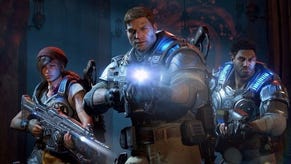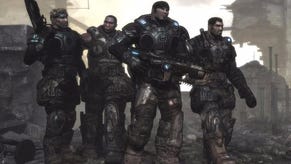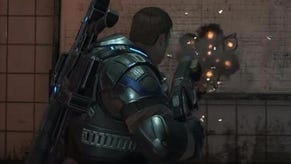Gears of War 4 is smarter than it is sensational
The Coalition's campaign is a sensitive and opulent retreading of some classic concepts and themes.
Editor's note: This is an early impressions piece based on a playthrough of Gears of War 4's campaign. Our full review will be published early next week once we've had experience of the full game on live servers.
If Gears of War 4 is about 'showing respect' for the past, to quote The Coalition's studio head Rod Fergusson, it's also about dealing with a terrible legacy. The game presents a gorgeous but devastated planet, bled almost dry of human life and buffeted by nigh-supernatural tornadoes - a potent if under-explored metaphor for 21st century climate change. In the course of the 10 hour campaign, you'll visit abandoned mining complexes that are now mass graves, their siderooms heaped high with rusty weapons, and dip into playable flashbacks that recount the final moments of anonymous grunts, inserted around the events of the Xbox 360 trilogy. In what feels strangely like a nod to the Izalith of Dark Souls 3, you'll wander through a dank and crumbling quasi-Pharaonic necropolis lit up by pulsing violet eggsacks, and peer at preposterous golden statues of the tyrants of yore.
You'll also pay witness to uncertain efforts at recovery. The first chapter is a raid on a Coalition of Ordered Governments settlement, a marriage of European medieval town planning and circuit board with a mobile curtain wall, where "DB" robots protect and police a depleted, unseen population. Though one of the more colourful environments - and a good platform for a tutorial section, thanks to a relative absence of visual noise - it's also a study in genteel desolation. The cobblestones and shrubbery have a waxy, unconvincing look, as though moulded on rather than laid or planted. In one of the hospitals, government posters preach to empty beds about the citizen's duty to reproduce.
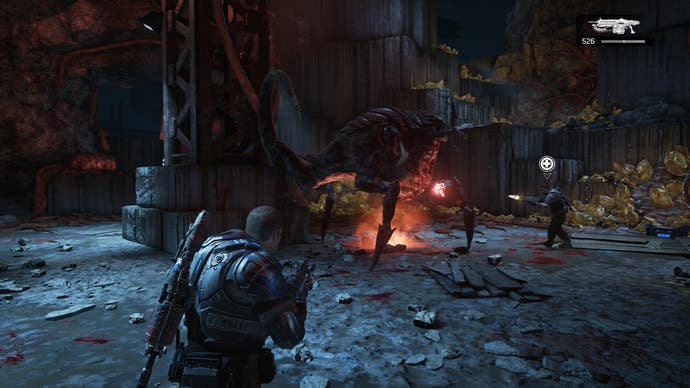
The game's treatment of the concept of aftermath isn't particularly profound - this is, at the end of the day, a pulpy cover shooter in which you can plant a grenade in somebody's neck fat, then boot your hapless victim right into somebody else before he detonates. You could argue that this isn't exactly new thematic territory for a Gears story, either - the first game is, after all, already famous for the opulent, shell-shocked dilapidation of its cities and factories. But Gears 4's portrayal of a ruined world is more sustained and naturalised than those of previous campaigns.
It's lent additional pathos by your awareness that this is one developer revisiting the work of another - a dynamic that is openly played upon in the shape of a scenario where you tour an old Pendulum War exhibit as part of a set-piece that is straight out of the original Gears playbook, with the player first assaulting an elevated turret, then using it to defend against a counter-attack. When new lead JD Fenix muses over a trashed diorama depicting the torrid battle of Anvil Gate from Gears 3, there's a moment of real poignancy. I know, JD, I know. I was there.
They don't make 'em like Gears 4 any more, and not just because the cost of developing campaigns this sprawling and baroque has become so outrageous. It's rare to find an action game campaign nowadays that is quite as restful as this one, for all the well-greased frenzy of the gunfights - a calm born of the steadiness with which the game's corridor crawls, narrative interludes, setpieces and "combat bowls" lock together, and the care, admittedly to the point of hesitancy, with which it makes you the master of each weapon or variable.
As with the 2006 original, the story unfolds within a single day, an older-school approach to narrative design that allows you to learn the ropes in real-time, more or less, alongside a cast of doe-eyed newcomers - hulking tearaway JD, his annoying buddy Del, and wasteland survivor Kait, who is more than she seems. It's the work of a team that has spent untold hours playing the original trilogy, and has developed an uncommonly refined sense of how much to thrust upon the player at any given moment - when to turn up the intensity and when to ease off, when to revive an earlier setup with a twist, and when to introduce something unexpected. Its interior sections alternate blind corners, arresting ornaments, chanced-upon vistas and intricate lighting effects to create a marvellous blend of reverie and suspense, which eventually explodes into full-bore open conflict.
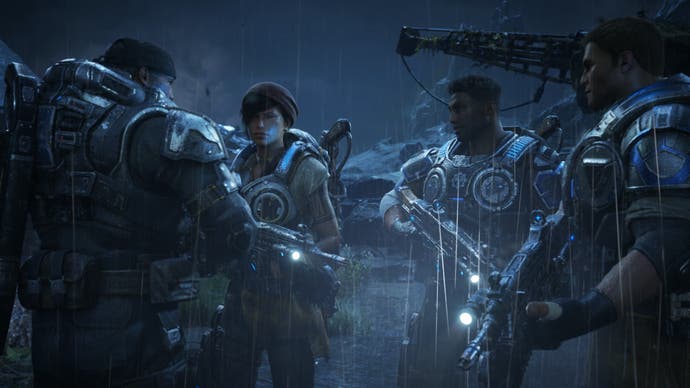
The bigger battles are in reality just one, perpetually revisited battle, an ur-encounter which is endowed with new quirks and conceits as the story wears on. In the first hour of the game, you'll be sliding along walls to aim shotguns and rifles at automatons who take cover and flank much as you do. By hour five, you'll be wielding eccentric toys like the Dropshot, a converted mining tool that spits out a flying bomb, to put down bestial opponents who can buff each other and swallow players whole, obliging allies to come to the rescue before you're carried away for digestion. You'll go from fighting in symmetrical courtyards with heavily telegraphed flanking routes and vantage points, to struggling through one-sided, mucky warrens in which the cover spots are unstable, plucked loose by gale-force winds that also hurl your grenades back into your face.
Very little of Gears 4's campaign is utterly original, and fans of the previous games may find the build-up too ponderous for comfort. Though lent a certain blistering charm by the introduction of flying drones armed with rocket pods and 180 degree energy shields, the plodding, unflinching robots who make up the bulk of the opposition in acts one and two simply aren't as entertaining to fight as the odious mutants who eventually succeed them. Later scenarios rank among the most engaging the series has offered, however, and there's immense satisfaction to seeing old ideas brought back with such confidence and style - be it in the use of branching, multiple elevation paths to put more stress on co-op play at points in the game, or the echo of Gears 1's "Knock, Knock" chapter, a level design masterclass, in the shape of an elevated half-moon plaza.
Where The Coalition has invented anew, it has often done so by taking old concepts in smart directions. The Trishot, for example, is a variation on the Mulcher Gatling gun in which individual barrels deactivate as the weapon overheats, gradually slowing the rate of fire where the Mulcher would cut off abruptly. The Pouncer is an enemy that combines the old Gears archetypes of pinner and flusher, driving you into hiding with a volley of tail barbs, only to jump on you while you're stationary. These tweaks and additions aren't revolutionary, but all of them are worthwhile, and if the campaign is perhaps a little too given over to wave survival scenarios that double as tutorials for the game's new Horde mode, the art direction does a brilliant job of disguising the element of repetition.

All Gears of War games are at risk of looking generic or artificial, because the demands of the combat formula are at odds with the ambient detail - you need plenty of square floorspace so that characters can jostle around one another, and of course you need lots of easily identifiable cover. It's a credit to the artists and programmers, then, that Gears 4's environments easily stand comparison with the likes of Uncharted 4 or Halo 5 - they're winding, organic, palpably lived-in spaces, sprinkled with backstory artefacts that are valuable less for themselves as for the fact that they encourage you to pay attention. Part of the trick is simply, again, that there's no cutting from place to place - you walk all the way into each edifice and all the way back out again, which gives architectural themes and the colour palette a chance to evolve under the eye. I particularly enjoyed the descent through the mining facility, which begins aboard an elevator the size of an oil rig and finds its way down to a nesting chamber that is all intestinal pinks and mucus yellows.
There are a few more pressing blemishes. The plot is unadventurous, settling firmly into a save-the-world groove for all the melancholy promise of the setting, though I found the final twist to be a pleasant surprise. The script is an effective source of team chemistry, with characters keeping up a gentle tempo of remarks and reactions, but is dulled by some sentimental flourishes and banter that is always at least one witty rejoinder too long. There are also a few needless, gimmicky pace-changers, such as an on-rails motorbike battle, and the boss battles, although grand, are leaden and devoid of mystique - think pushing buttons to activate a terrain trap, or shooting at exposed weaknesses on cue.
On the whole, though, Gears of War 4's campaign is both a return to form on par with this year's Doom reboot, and a triumphant debut for the developer once known as Black Tusk Studios. It is dependable rather than dazzling, and the flourishes are in permanent danger of being lost in Epic's shadow, but you can set your watch by the robustness of the craftsmanship. Gears of War 4 might seem brutish and grotesque on the surface, a game of lurid viscera and chunky, pop-out magazines, but it is secretly a work of great intelligence and sensitivity that augurs very well indeed for Gears stories to come.



